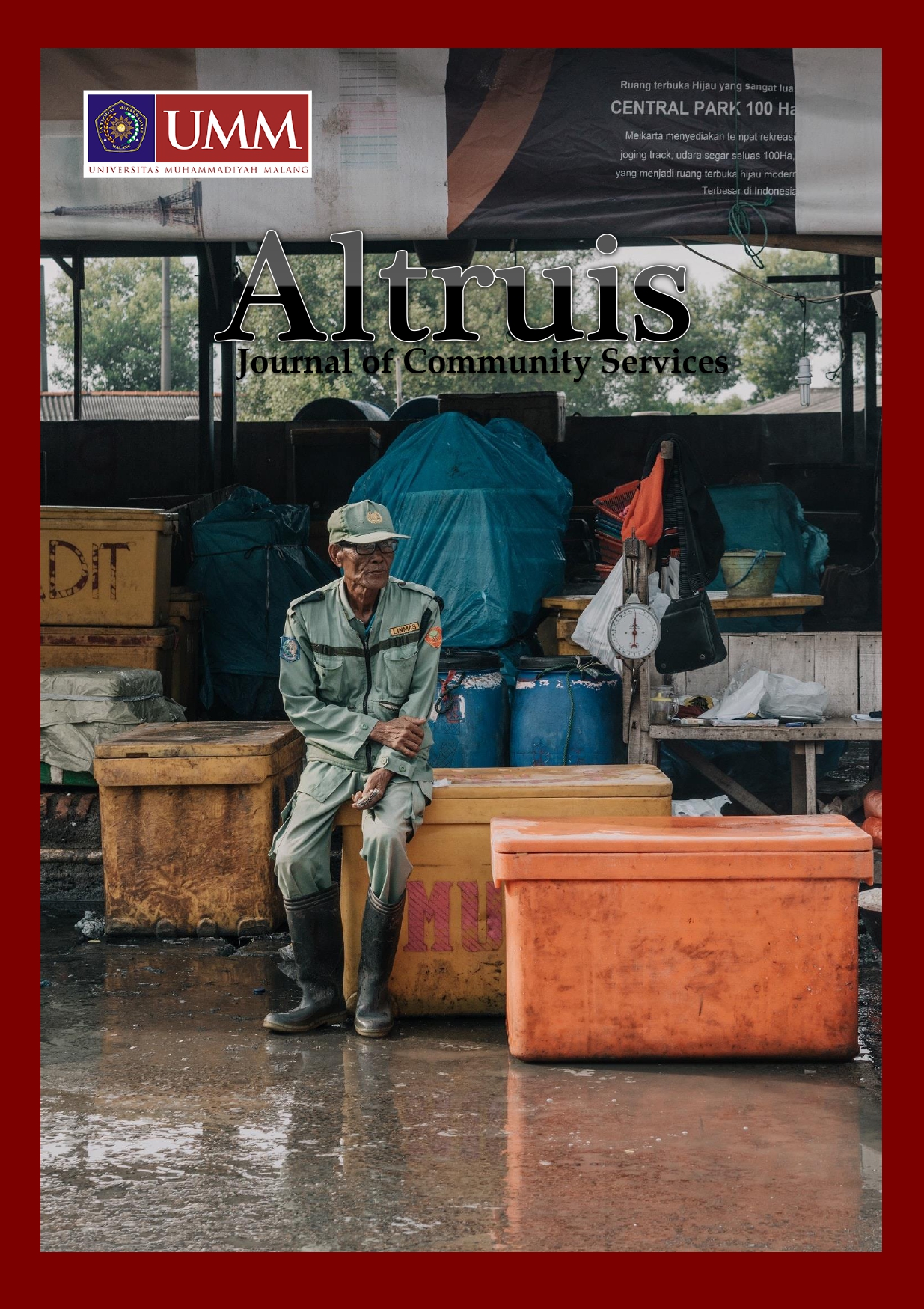Kesiapsiagaan Masyarakat dalam Menghadapi Gempa Bumi (Mengenang 14 Tahun Silam Gempa Bumi Bantul, Yogyakarta)
DOI:
https://doi.org/10.22219/altruis.v1i2.12184Keywords:
Community Preparedness, EarthquakeAbstract
The earthquake hit Bantul regency, Yogyakarta, has brought life lesson for us that preparedness is urgently demanded to face potential earthquake in the future. This publication aims to discover how is both government and society readiness to act when earthquake strikes on unprecedented times. Method employed was literature study method by conducting in-depth analysis towards literatures related to earthquake disaster in Bantul in the year of 2006. This study revealed that Bantul dwellers have been high alerted to face earthquake. The disaster preparedness covers a range of fields which are on public facility, information system, physics or building, economy, education, society’s capacities enhancement, and religion.Downloads
References
Abe, M., Ochiai, C., & Okazaki, K. (2018). Is post-disaster housing reconstruction with participatory method effective to increasing people’s awareness for disaster prevention? Procedia Engineering, 212, 411–418. https://doi.org/10.1016/j.proeng.2018.01.053
Aulady, M. F. N., & Fujimi, T. (2019). Policy Implication for Economic Losses Reduction Due to Earthquake Disaster in Bantul City, Indonesia. IOP Conference Series: Materials Science and Engineering, 462(1). https://doi.org/10.1088/1757-899X/462/1/012051
BNPB. (2015). Kerangka Kerja Sendai untuk Pengurangan Risiko Bencana 2015-2030. https://doi.org/10.1377/hlthaff.2013.0625
BPBD Kabupaten Bantul. (2017). LKJ 2017. Bantul: Badan Penanggulangan Bencana Daerah Kabupaten Bantul.
Brata, A. G., de Groot, H. L. F., & Zant, W. (2018). The Impact of the 2006 Yogyakarta Earthquake on Local Economic Growth. Economics of Disasters and Climate Change, 2(2), 203–224. https://doi.org/10.1007/s41885-018-0026-5
Carter, W. N. (2008). Disaster Management : A Disaster Manager’s Handbook. Retrieved from https://www.think-asia.org/bitstream/handle/11540/5035/disaster-management-handbook.pdf?sequence=1
CDC. (2014). Disaster Preparedness and Response Training. Retrieved from https://www.cdc.gov/nceh/hsb/disaster/Facilitator_Guide.pdf
CRS. (2002). Emergency Preparedness & Response Handbook. Retrieved from http://static1.1.sqspcdn.com/static/f/752898/10551353/1296749572987/EmergencyPreparednessAndResponseHandbook.pdf?token=CITvTfrkELWqHc8MSqNCpeILYh0%3D
Deni Darmawan. (2013). Metode Penelitian Kuantitatif. Bandung: PT. Remaja Rosdakarya.
Granberg, T. A. (2013). Preparedness Measures for Emergency and Disaster Response. Humanitarian and Relief Logistics, (Research Issues, Case Studies and Future Trends), 59–75. https://doi.org/10.1007/978-1-4614-7007-6_4
Hamid, N. (2018). Study of Community Capacity in Dealing With The Threat of Shore Erosion in Kragan Subdistrict Rembang District. Pancaran Pendidikan, 7(3), 57–70. https://doi.org/10.25037/pancaran.v7i3.193
Hamid, N. (2020). Urgensi Pendidikan Kebencanaan Kepada Masyarakat. Equilibrium: Jurnal Pendidikan, VIII(2), 232–239. https://doi.org/https://doi.org/10.26618/equilibrium.v8i2.3444
Ikaputra. (2019). People with Different Abilities and Disaster—Lessons Learned from Jogjakarta, Post-earthquake 2006–2016. In Japan Study as a Public Good in Asia (pp. 55–59). https://doi.org/10.1007/978-981-13-6336-8
John W. Creswell. (2013). Research Design Pendekatan Kualitatif, Kuantitatif, dan Mixed (A. Fawaid, ed.). Yogyakarta: Pustaka Pelajar.
Khotimah, N., Purwantara, S., Dewi, U., Majima, K., & Hiroyuki, K. (2019). School Preparedness in Anticipating the Threat of Earthquake and Tsunami in Bantul Regency. IOP Conference Series: Earth and Environmental Science, 271, 1–10. https://doi.org/10.1088/1755-1315/271/1/012005
Kusumasari, B. (2012). Network organisation in supporting post-disaster management in Indonesia. International Journal of Emergency Services, 1(1), 71–85. https://doi.org/10.1108/20470891211239326
Kusumasari, B., & Alam, Q. (2012). Bridging the gaps: The role of local government capability and the management of a natural disaster in Bantul, Indonesia. Natural Hazards, 60(2), 761–779. https://doi.org/10.1007/s11069-011-0016-1
Muhajir, N. (2000). Metode Penelitian Kualitatif. Yogyakarta: Rake Sarasin.
Muri Yusuf. (2014). Metode Penelitian Kuantitatif, Kualitatif, & Penelitian Gabungan. Jakarta: Prenadamedia Group.
Resosudarmo, B. P., Sugiyanto, C., & Kuncoro, A. (2012). Livelihood Recovery after Natural Disasters and the Role of Aid: The Case of the 2006 Yogyakarta Earthquake. Asian Economic Journal, 26(3), 233–259. https://doi.org/10.1111/j.1467-8381.2012.02084.x
Setyaningrum, N., & Rumagutawan, R. (2018). Tingkat Pengetahuan Penanggulangan Bencana dan Kesiapsiagaan Bencana Gempa Bumi Pada Kepala Keluarga di Dusun Kiringan Canden Jetis Bantul Yogyakarta. Health Sciences and Pharmacy Journal, 2(3), 103–110. https://doi.org/10.32504/hspj.v2i3.44
Sun, L., Deng, Y., & Qi, W. (2018). Two Impact Pathways from Religious Relief to Public Disaster Response: Findings from a Literature Review. International Journal of Disaster Risk Reduction, 27(August 2017), 588–595. https://doi.org/10.1016/j.ijdrr.2017.10.004
UNISDR. (2009). Terminology on Disaster Risk Reduction. Geneva, Switzerland: United Nations International Strategy for Disaster Reduction.
Wulandari, R. (2017). Analisis Kesiapan Pemerintah Daerah dalam Penanganan Penyandang Disabilitas Menghadapi Bencana Gempa Bumi. Jurnal Prodi Manajemen Bencana, 3(1), 23–41.Downloads
Published
How to Cite
Issue
Section
License
Authors who publish in Altruis agree to the following terms:
- For all articles published in Altruis, copyright is retained by the authors. Authors give permission to the publisher to announce the work with conditions. When the manuscript is accepted for publication, the authors agree to automatic transfer of the publishing right to the publisher.
- Authors retain copyright and grant the journal right of first publication with the work simultaneously licensed under a Creative Commons Attribution-ShareAlike 4.0 International License that allows others to share the work with an acknowledgment of the work's authorship and initial publication in this journal.
- Authors are able to enter into separate, additional contractual arrangements for the non-exclusive distribution of the journal's published version of the work (e.g., post it to an institutional repository or publish it in a book), with an acknowledgment of its initial publication in this journal.
- Authors are permitted and encouraged to post their work online (e.g., in institutional repositories or on their website) prior to and during the submission process, as it can lead to productive exchanges, as well as earlier and greater citation of published work (See The Effect of Open Access).
This work is licensed under a Creative Commons Attribution-ShareAlike 4.0 International License.


